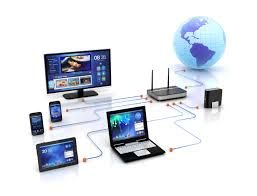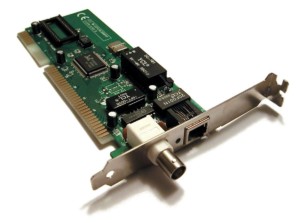IT networks are also referred to as data networks, computer networks or digital telecommunications networks. These networks are made up of nodes (computers, servers and gadgets) that share information and resources with each other. Nodes are connected to each other using wired and wireless links. Some wired links include copper and fibre optic cables. (Source)

Networking & Storage Parts
IT networking and server parts are responsible for providing a huge number of services and applications in today’s world such as audio and video sharing, access to the World Wide Web, access to printers, data storage servers, fax machines and support for instant messaging and email applications. IT networks have come a long way over the years. The internet is considered the largest IT network in the world as it connects billions of devices located across the world. The essence of any computer network is to make it easier for files and resources to be shared among different users irrespective of their location.
Basic IT Networking and Server Parts
Computer networks are made up of many different components that have unique functions and specific features. Some of the common components you can find in a typical IT network include network interface card (NIC), networking software resources, shared printers and fax machines, shared data, transmission media, clients, servers, network operating system (NOS) and local operating system (LOS). As you can tell, you can find both hardware and software components in a typical IT network setup. All these components are necessary for the normal functioning of the network. Here is a look at each individual component:
SERVERS
Servers are basically special computers that hold the network operating system (NOS), shared programs and shared files. The main work of servers is to ‘serve’ or provide access to networked information and resources to all nodes or users in the network. Currently, there are many different types of servers. Depending on the kind of IT network you wish to set up, you can choose to use a web server, fax server, database server, communication server, main server, print server, file server or any other appropriate server installation. You can have more than one server in a single IT network for better functionality and improved sharing of files and resources.
Being fundamentally computers, servers include all features of a typical workstation computers minus the conventional output devices. Servers therefore have processors, motherboards, memory chips and storage disks. Their features vary depending on their area of application and cost. Servers mostly run on special operating systems that are different from the ones used on normal workstations.
ROUTERS
Routers are also considered IT networking and server parts because they are used to connect local networks to the World Wide Web. A router can be used to connect a single workstation computer or several workstation computers to the internet. In the case of several computers, a router facilitates sharing a single internet connection among the computers that form a local Area Network. Home networks and small business networks that would like to have internet access in all their computers can make use of a router to set up a connection.
There are two types of choices when it comes to routers; there are wireless and wired routers. Depending on your location, setting, internet speed needs, and budget, you can choose to have either of the two installed.
SWITCHES
Switch is a networking gadget that is very similar to a hub but with extra features for data transmission. While a hub can only broadcast request-responses from the server to the entire network, a switch can send the request-response information back to the specific computer that made the request. This is made possible by including physical device addresses in all messages that sent through the switch. Like a hub, a switch has various connection lights, power supply and RJ-45 ports.
CLIENTS
In IT networking, the computers or workstations found in the network are normally referred to as clients. Clients are therefore all desktop, laptop or special computers that are part of the network and are allowed to share the network files and resources. Clients are also referred to as users in the case of a network in an organization or company. Being clients, these computers can make requests to the servers for specific information or resource allocation.
HUB
A hub is a gadget that allows multiple computers to connect to a single network. The hub converts as single network port into multiple connections points that can be used to link several individual nodes or devices. In practice, all computers connected to an IT network must be connected to a hub which then links all the computers to a main server. Requests from computers must go through the hub before being relayed to the server. Responses are also received by the hub from the server and broadcasted back to the network for the relevant computer to decode. The hub therefore handles nearly all transmission processes that take place in the network at any given time.
Network Interface Cards
Every computer that is connected to a computer network must have a network interface card (NIC). The NIC basically manages the flow of data between the computer and the network. Data must be encoded into a specific format before it can be sent through transmission media to other devices in the network. The device that receives the data must decode the data it receives. The work of the NIC is to encode and decode this data as it flows into and out of the network and into the computer. (source)

Network Interface Card
Conventional workstation computers have network interface cards that have ports for wired connections. The cards are strategically placed at the back of the system unit for desktop computers. Laptop computers have their network interface cards strategically placed on the edges for easy access to the wired ports. Other computing gadgets such as mobile phones and tablets also have network interface cards built into their motherboards chips. In their case, the network interface cards are wireless meaning they connect to computer networks using Wi-Fi.
Transmission Media
Transmission media are another key component of IT networking infrastructure. Transmission media interconnect all the individual components in the network from servers to workstations to printers to networking gadgets such as routers and repeaters. Transmission media are also referred to as network lines, links or channels. Some common types of transmission media include fibre optic cables, coaxial cables and twisted-paid wires.
Shared Data
Shared data is any information, application or resources that is stored in a server that is meant for use by client computers or users in a computer network. The data can be anything from digital files to software programs and email applications. The main aim of setting up a computer network is to facilitate easily sharing of data. A good example is where a company facilitates access to an inventory database from employee computers for faster and convenient business operations. Shared data saves on data retrieval times and reduces effort needed to sort and updated data as well.
Shared Printers and Other Peripheral Gadgets
Printers, fax machines, scanners and other computer peripheral gadgets can also be incorporated into an IT network for easy sharing by multiple clients or users. These vital hardware resources may be in high demand especially in organization or businesses with limited computing resources. To make sharing of these hardware devices easier and convenient, they can be linked to an IT network and used by users on the network.
Special servers are usually allocated to manage the sharing of these hardware resources effectively among all clients in a network. The servers are set aside to facilitate easy sharing of hardware software and drivers. The servers also manage requests from clients and queue the data is processed to and from these hardware resources.
Local Operating System
A local operating system is basically the software program that allows you to use your workstation computer before it is even connected to any computer network. Examples of local operating systems include Mac OS, Linux, Ubuntu and Windows OS. A local OS allows you to view files on your computer’s hard drive, print document using a local printer, listen to audio files, watch videos and use disk drives among many other tasks.
Network Operating System
This is an operating system that is installed on a computer or server to allow either to communicate with other devices on a computer network. The OS helps with management of network resources, file sharing as well as network authentication and security. Network operating systems are not very popular so special training may be needed to use them.
All these IT networking and server parts make data transmission and storage possible in both small, medium and large computer networks in many parts of the world.
Send us a
